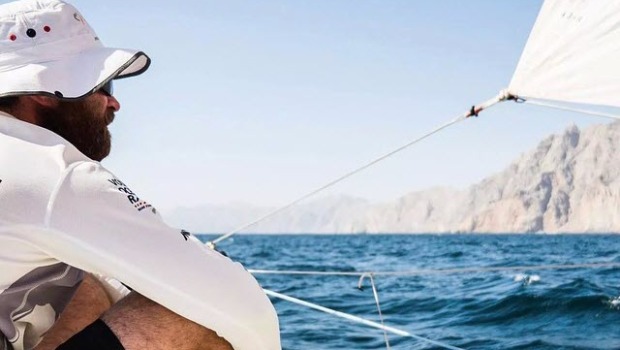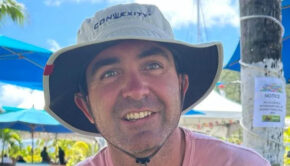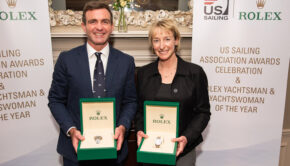Team Alvimedica: Moving in the right direction
Published on December 18th, 2014
The American/Turkish flagged Team Alvimedica is the youngest Volvo Ocean Race crew, and in a race that rewards experience, the team is working hard to improve in all areas. Now having completed two legs of the race, Skipper Charlie Enright (USA) checks in with Scuttlebutt editor Craig Leweck to share their progress.
After finishing the second leg from Cape Town to Abu Dhabi, what was included in the team’s debrief?
We feel like our boat speed, which is probably the most important thing in this game, has come a long way since the first leg. We had moments of brilliance during Leg Two, leading out of Cape Town after the start, and when we’re next to other boats, we feel fast in most conditions. I feel like when the conditions are fairly static, we could lock in really well, and our boat speed could be seen as a strength compared to our competitors. But I feel like when the conditions are unstable and not as straightforward, sometimes we don’t lock in as quickly as the top three. But it’s definitely been improving and we have some plans to push it further.
But the biggest area to learn from during the second leg was some of the decision making within the tactical plan. We’ve put a new system in place that should help some of that. In terms of the relationship between myself and Will Oxley (navigator) and the watch captains, we need to as a group operate a little more efficiently, and also in how we work with the rest of the crew, so that we are all on the same page.
In this race, it seems like you’re rewarded for staying with the fleet, in more ways than one. If you look at this last leg, as soon as anybody left, they died. And the boats that stayed together had a two boat tuning session all the way to Abu Dhabi. So being with the pack, it’s two-fold. It makes it a little bit more difficult with six hour skeds, so that’s something that we got to obviously be conscious of.
So in general, we’re continuing to improve, and if our decision-making improves as much as our boat speed did over the last stop-over, we’re primed for good things.
Tactically, how do you balance remaining conservative within the fleet – which you often can’t see – against the desire to make decisive decisions based on your weather inputs?
I think our goal is to manage the fleet as best as possible and only to deviate when we have high confidence in our weather and in an alternate strategy. I think, just looking at this leg and the last leg, the peloton is a pretty strong thing and we don’t mind being a part of it, especially with our improving boat speeds. Obviously there are times to separate for sure, but I think in general, being a little bit more conservative, especially early in this race, will help us a tremendous amount.
In this particular leg, we got jumped, basically, with the fleet going to the north between sked reports. We went from being the middle boat, and six hours later to being – other than SCA – the eastern boat, and when you combine that with falling off the back of a warm front, it led to a little bit of a loss. But again, we got fortunate enough to get back with the group and continued pace with them. But then the final straw for us was getting dumped by the rest of the fleet in a cloud.
We got within a half mile of Dongfeng, but under a rain cloud about eight days out, we watched them furl their masthead zero and get back on the J1 in the gradient. We had to sit there parked for another two hours, and from that point on we saw the rich getting richer in front of us. The cloud was a first in first out operation, and they earned that position to do it.
There’s a little bit of luck, but also at some stage you make your own luck, and we need to get better at managing some of the clouds, particularly in the doldrums areas, which is part of our inexperience. Between Will and to some extent Ryan Houston, we have some pretty salty guys, and they’re very helpful with that stuff. But as a group we need to continue to improve on it.
Regarding speed improvement, what seems to be some of the big variables that you guys have determined?
It’s crossovers, really. When I say that, I mean crossovers for everything – what sail to have up when, where to position the stack – both internal and external, when do you use the water ballast, daggerboard heights, outrigger heights, there’s a ton. Managing the angle of heel on these tender things is pretty important. There are just a lot of variables. We learned, like we thought we would, more on the first leg than we did in the six months leading up to this thing. I think the same could be said for some of our decision making in this second leg.
You’ve done a lot of one design racing, and when you are speed testing with other boats, even in the best of circumstances, it’s hard to assess the impact of changes. In this race, you’re trying to improve your speed when, a lot of times, you can’t even see your competitors. How are you able to measure the impact of changes as you seek to improve your speed?
You’re absolutely right. I think when you’re alone, there’s too many variables to be certain. Between instrument calibration, wind type, tidal influence, varying helmsman… it can be very difficult to quantify when you’re by yourself. All you really have are your polars and your sailing performance software, and you can go off that but as we all know, it’s garbage in, garbage out. So the best way to do it is to refine these things when you’re around the fleet.
This race is such that you are around the fleet a fair bit. So in those first couple days, or in the case of Dongfang and Brunel who were together nearly the entire second leg, you have to be as observant as possible because there’s certainly things to learn from the competition.
We have everybody on our team going through to the Volvo image bank right now. We’ve assigned each person a certain boat and it’s their job to see what they can find. There’s so much video and photos available, all of which we are unaware of during the leg. But in between legs, we now have a months’ worth of media to sort through. So we are now going to school on the fleet to see what we can learn.
Any crew changes for the third leg?
No, not on our boat.
The top three boats are arguably the most experienced of the teams. Hard to fast track experience.
When we left Cape Town, we felt great and we were totally on fire in those particular conditions. It would have been quite the leg if those conditions held all the way to the finish. But yeah, we need to continue to work on our boat speed and in our decision making process to allow us to stay with the pack. But we are definitely moving in that direction.
—————–
Background: The 2014-15 Volvo Ocean Race began in Alicante, Spain on Oct. 11 with the final finish on June 27 in Gothenburg, Sweden. Racing the new one design Volvo Ocean 65, seven teams will be scoring points in 9 offshore legs to determine the overall Volvo Ocean Race winner. Additionally, the teams will compete in 10 In-Port races at each stopover for a separate competition – the Volvo Ocean Race In-Port Series. The third offshore leg from Abu Dhabi, UAE to Sanya, China is 4,670 nm, with the start on Jan. 3 and the ETA on Jan. 23-31. Race website: http://www.volvooceanrace.com/en/home.html









 We’ll keep your information safe.
We’ll keep your information safe.